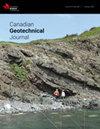生物聚合物在植被土壤中促进植被生长和提高整体强度
IF 3.5
3区 工程技术
Q2 ENGINEERING, GEOLOGICAL
引用次数: 0
摘要
种植植被是一种可持续的、生态友好的浅坡稳定方法。然而,在水资源有限的地区,这种方法面临着一些挑战,比如植被生长迟缓,导致土壤得不到保护。生物聚合物具有促进植被生长和增强土壤强度的潜力,因此本文通过植被栽培和直剪试验,对生物聚合物辅助植被加固土壤的可能性进行了测试。糖基和蛋白质基生物聚合物都提高了植物生长的水分利用率和养分吸收。采用最合适的多糖黄原胶,进一步探讨处理条件(即掺合量)和外部环境(即降水)对植被土壤性能的影响。在多种供水条件下,黄原胶中掺量为0.5%(即相对于干土质量)时抗剪切加载能力的提高最为显著。这表明,在植物生长初期使用适当剂量的生物聚合物,应提供土壤颗粒之间适度的结合强度,同时不阻碍根的渗透。研究结果表明,生物聚合物与植物结合使用对土壤加固效果最好。本文章由计算机程序翻译,如有差异,请以英文原文为准。
Vegetation growth promotion and overall strength improvement using biopolymers in vegetated soils
Planting vegetation is a sustainable and eco-friendly method for shallow slope stabilization. However, in water-limited regions, this method is facing challenges like retarded vegetation growth, which leads to unprotected soils. Biopolymer, with potentials in both vegetation growth promotion and soil strength enhancement, is therefore tested in this paper with regard to its possibility in assisting soil reinforcement with vegetation through vegetation cultivation and direct shear tests. Both sugar-based and protein-based biopolymers improved water availability to growing plants and nutrient uptake. The most suitable polysaccharide xanthan gum was adopted to further explore the effects of treatment condition (i.e., blending content) and external environment (i.e., precipitation) on the vegetated soil performances. Under a variety of water supply, xanthan gum with a medium blending content of 0.5% (i.e., with respect to dry soil mass) led to the most substantial improvement in the ability to resist shear loading. This indicates that the appropriate dosage of biopolymer used at the initial stage of plant growth, should provide moderate bond strength between soil particles, whilst not impeding root penetration. Supported by the obtained results, biopolymer is suggested to be used in combination with plants for soil reinforcement for the best efficiency.
求助全文
通过发布文献求助,成功后即可免费获取论文全文。
去求助
来源期刊

Canadian Geotechnical Journal
地学-地球科学综合
CiteScore
7.20
自引率
5.60%
发文量
163
审稿时长
7.5 months
期刊介绍:
The Canadian Geotechnical Journal features articles, notes, reviews, and discussions related to new developments in geotechnical and geoenvironmental engineering, and applied sciences. The topics of papers written by researchers and engineers/scientists active in industry include soil and rock mechanics, material properties and fundamental behaviour, site characterization, foundations, excavations, tunnels, dams and embankments, slopes, landslides, geological and rock engineering, ground improvement, hydrogeology and contaminant hydrogeology, geochemistry, waste management, geosynthetics, offshore engineering, ice, frozen ground and northern engineering, risk and reliability applications, and physical and numerical modelling.
Contributions that have practical relevance are preferred, including case records. Purely theoretical contributions are not generally published unless they are on a topic of special interest (like unsaturated soil mechanics or cold regions geotechnics) or they have direct practical value.
 求助内容:
求助内容: 应助结果提醒方式:
应助结果提醒方式:


